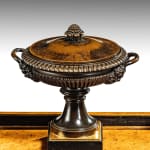George IV Walnut Inkstand Attributed to Benjamin Lewis Vulliamy (1780-1854)
23 x 48 x 24 cm
Further images
-
(View a larger image of thumbnail 1
)

-
(View a larger image of thumbnail 2
)

-
(View a larger image of thumbnail 3
)

-
(View a larger image of thumbnail 4
)

-
(View a larger image of thumbnail 5
)

-
(View a larger image of thumbnail 6
)

-
(View a larger image of thumbnail 7
)

-
(View a larger image of thumbnail 8
)

-
(View a larger image of thumbnail 9
)

-
(View a larger image of thumbnail 10
)

With ebony mouldings and patinated bronze mounts; of rectangular form, fitted with one long drawer at the front with a lion’s head and axe-head handle. There are two long ebonised pen-troughs with ormolu moulding along the length of its top, centred by a gadrooned tazza for wax wafers which has a satyr’s mask handle on either side and is topped with a berry finial. This is flanked by two covered urns, ornamented with a ram’s head on either side and with acorn finials. One urn serves as an inkwell, the other as a sander.
The inkstand’s design reflects the early 19th century French antique manner which was disseminated by Thomas Hope’s ‘Household Furniture and Interior Decoration’, 1807 – see the shape of the vase with its acorn finial and the rams’ head decoration in Plate XLVII, p.113; and also the shape of the vase and its finial in Plate XXXIII, p.85 (Thomas Hope, ‘Household Furniture and Interior Decoration: Classic Style Book of the Regency Period’ (Dover Publications, Inc, New York, 1971)).
A very similar inkstand, attributed to Benjamin Lewis Vulliamy, can be found in the Royal Collection (RCIN 996). This inkstand is made of rosewood with ebony stringing and gilt metal. It is dated 1800-30. It is of very similar design to ours, with a central urn-shaped sander flanked by two inkwells with rams’ head handles (photographed here without their lids), a recess for pens and a drawer with a lion mask loop handle on the long side.
Another very similar inkstand was sold by Jeremy Ltd in 1999. Again, it has the single pair of urns which are mounted on either side of a central tazza of similar form, also with a berry finial.
A closely connected inkstand by Benjamin Lewis Vulliamy can be found in the Royal Collection (RCIN 3614). This inkstand is made of oak, veneered with ebony and mounted in bronze and gilt bronze. It is fitted with three drawers and two dished pen-troughs veneered in sycamore. On the top are two sphinx paperweights, placed on either side of a central gadrooned tazza with four smaller urns at the corners – all of patinated bronze. The pair of troughs, the central tazza and the two pairs of urns closely resemble those on our inkstand. This inkstand was bought by George IV on 25 April 1810 from the Vulliamys for the Blue Room at Carlton House and ‘cost the exceptionally high price of 105 guineas’ (Geoffrey de Bellaigue, ‘The Vulliamys and France’ in ‘Furniture History Volume III’ (W.S. Maney and Son Ltd, Leeds, 1967), p.49). It is illustrated in the exhibition catalogue ‘Carlton House: The Glories of George IV’s Palace’ (The Queen’s Gallery, Buckingham Palace, 1991-2), cat.no.165, p.190.
Benjamin Lewis Vulliamy was a clockmaker active in 18th and 19th century Britain. He was the third generation in his family’s clockmaking firm and succeeded his father, Benjamin Vulliamy, as head of the firm and Clockmaker to the Crown. He was clockmaker to King George III and his son, the Prince Regent, later King George IV, William IV and Queen Victoria. Benjamin Lewis Vulliamy supplied clocks to government offices as well as the Royal palaces, including Windsor Castle. Vulliamy was a man of considerable ingenuity and introduced several peculiarities and improvements into his clocks.
Vulliamy was elected associate of the Institution of Civil Engineers on 13 March 1838. He became Free of the Clockmakers’ Company in 1809, was admitted to the livery in 1810, and held the office of Master five times in 1821, 1823, 1825, 1827 and 1847. He was elected a fellow of the Royal Astronomical Society in 1831.
Vulliamy was knowledgeable about architecture, paintings and engravings. His library was extensive and he possessed a collection of ancient watches. He died on 8 January 1854 leaving two sons, Benjamin Lewis (1817–1886) and George John. Neither of his sons followed him in his business.










